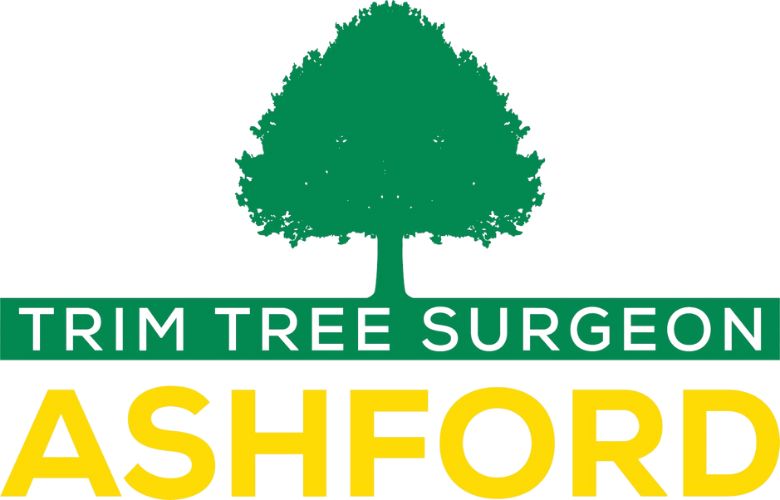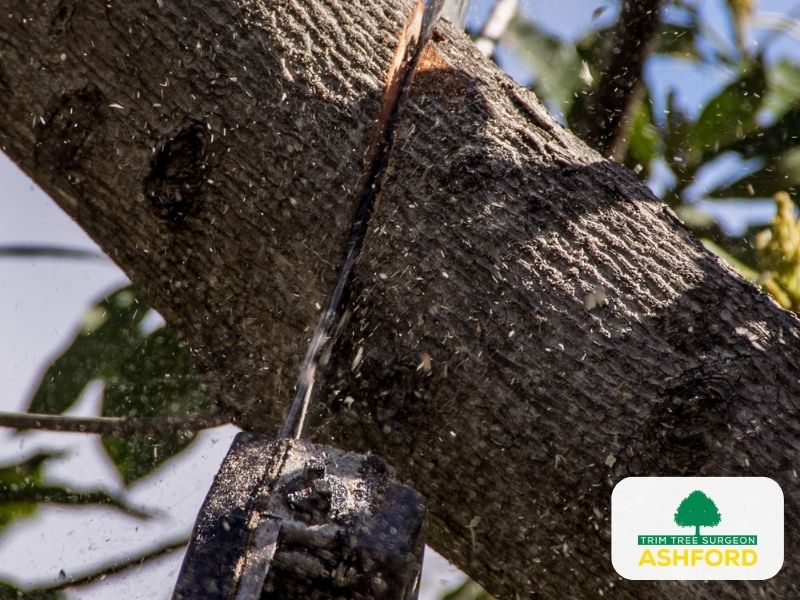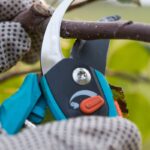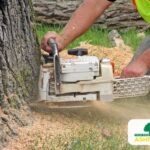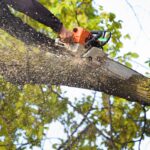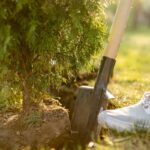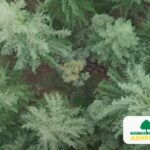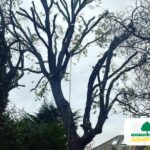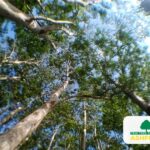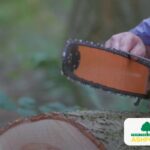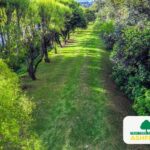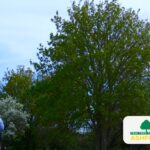Imagine a lush and vibrant landscape in the UK, with towering trees providing shade, shelter and beauty. These majestic beings have withstood the test of time, witnessing seasons pass and the lives of countless creatures. However, there may come a time when these benevolent giants must be removed.
Tree removal is not taken lightly in the UK; it is a decision made only when absolutely necessary.
Diseases and pest infestations can cause havoc to a tree’s health, compromising its structural integrity and making it vulnerable to collapse. Storms or other natural disasters can also cause significant structural damage, making tree removal necessary for safety. Overgrown branches or weak limbs can be a risk to surrounding structures and people, so must be removed. Invasive roots can cause damage to underground utilities and foundations, so must be dealt with swiftly.
Landscape renovation projects may also require the removal of particular trees to create space for new developments or improve aesthetics. Lastly, when a tree is in decline or has died completely, it must be removed promptly to prevent any further risks.
This article will discuss the reasons for tree removal in more detail, so you can understand when and why it’s necessary in the UK.
Disease and Pest Infestation
Disease and pest infestations can cause trees to wither away, necessitating their removal. Prevention is key to keeping trees healthy. Regular inspections can detect early signs of diseases such as fungal infections or bacterial blights, enabling timely treatment which can prevent spread and save the tree. Pest management is also important. Insects like aphids, beetles, or borers can weaken trees by feeding on their leaves or burrowing into trunks. Timely intervention through insecticides or biological controls can help mitigate damage.
When disease and pest infestations become severe and irreversible, removing the affected tree is the last resort to protect neighboring healthy vegetation from contamination. Moving onto the next section about ‘structural damage’, it is essential to consider how external factors may lead to tree removal.
Structural Damage
When it comes to assessing the risk of tree failure, there are several signs of structural damage to look out for. These include cracks in the trunk or major branches, hollows within the tree, and trees that are leaning or tilting.
It’s important to remove trees that are structurally compromised as they pose a significant risk of falling and causing damage or injury.
Signs of structural damage in trees
Despite passing time, trees may show subtle signs of their vulnerability through structural damage. Assessing tree stability is essential to identify any clues of such damage and decide whether tree removal is necessary.
Cracks or splits in the trunk or branches are a key sign of a weakened structure. Furthermore, leaning or tilting trees may indicate root problems or soil instability, which can further damage the tree.
Deadwood and decay also signal structural weakness, compromising the tree’s ability to support itself. Regular tree maintenance techniques, such as pruning and bracing, can help to reduce these issues. However, if signs of structural damage remain despite these efforts, then it’s important to assess the risk of tree failure and consider removal options.
Assessing the risk of tree failure
Assessing the risk of tree failure is essential for protecting your property and loved ones. Regular assessments of tree health and preventive tree care can help identify potential risks before they become dangerous.
Here are three factors to consider when assessing the risk of tree failure:
Visual Inspection: Look out for signs of decay, such as cavities or cracks in the trunk, dead branches, or fungal growth. These indicate structural damage that may lead to failure.
Tree Mechanics: Assess the structure and strength of the tree. Check for included bark (where two branches grow too close together), poor branch attachments, or excessive leaning.
Environmental Factors: Consider how external conditions may affect the tree’s stability. This includes soil quality, wind exposure, and proximity to structures.
Assessing these factors helps determine whether a tree is at risk of failure. It’s essential to recognize the importance of removing structurally compromised trees without delay for safety reasons.
Importance of removing structurally compromised trees
It’s essential to remove structurally compromised trees quickly to keep people and property safe, and to maintain the beauty of the surroundings. Assessing tree health is an important step in determining if a tree is structurally compromised. Decay, fungal growth, deadwood, or pest infestations can weaken a tree’s structure and increase the risk of failure.
By removing these compromised trees, you prevent potential hazards and help to protect healthy trees in the vicinity by preventing the spread of diseases or pests. Removing structurally compromised trees promptly not only keeps everyone safe, but also helps preserve the health and aesthetic of the landscape.
Now, let’s look at the safety concerns associated with unstable trees.
Safety Concerns
One of the most common reasons for tree removal is because they can become a potential hazard, causing harm or damage if not properly maintained. Assessing the safety of trees is essential to reduce risks and ensure the safety of people and property. Here are three key safety concerns that may require tree removal:
Structural Instability: Trees with weakened or compromised branches, trunks, or roots may be prone to falling, particularly during extreme weather conditions.
Disease and Decay: Infected or decaying trees can become unstable and prone to collapsing without warning, posing a threat to nearby structures or people.
Overhanging Branches: Tree limbs that hang over pavements, roads, or buildings present potential dangers as they can break off suddenly.
Understanding these safety concerns helps homeowners and professionals make informed decisions about tree removal in order to protect their surroundings from potential hazards. Speaking about threats posed by invasive roots…
Invasive Roots
When dealing with tree roots and their effects on structures, it’s crucial to comprehend the potential harm they can cause.
Signs of root damage include cracks in walls or foundations, uneven floors, and plumbing problems.
If these signs are spotted, it may be necessary to remove trees with invasive roots to prevent further damage and guarantee the safety of your property.
Understanding the impact of tree roots on structures
Tree roots can intertwine with building foundations, causing potential damage and structural issues. It’s essential to understand the impact of roots on structures in order to keep them in good condition. Here are three key points to help you grasp the issue:
Force Exertion: Roots can exert force against structures, particularly during high water uptake or strong winds. This force can weaken foundations, causing cracks, tilting, or even collapse.
Moisture Absorption: Roots absorb moisture from the surrounding soil. As they draw water away from the ground beneath buildings, it can result in soil shrinkage and subsequent foundation settlement.
Piping Interference: Invasive roots can infiltrate underground drainage systems or utility pipes connected to buildings. Their growth can obstruct flow and cause blockages and damage.
It’s important to understand how root systems affect structural integrity to make informed decisions about tree removal.
Now let’s look at signs of root damage.
Signs of root damage
Take a moment to imagine your home as a sturdy ship sailing through the sea of life, with its foundation acting as the anchor that keeps it steady. Now, picture tree roots as mischievous little creatures trying to pry that anchor loose, potentially causing damage and instability to your beloved vessel.
Ensuring root health is essential in avoiding root damage, which can have serious consequences for your property. Signs of root damage include cracks in walls or floors, uneven settling of the building, plumbing issues such as blockages or leaks, and even trees leaning towards structures. It’s vital to address these signs quickly to prevent further harm.
In the next section, we’ll discuss when to remove trees with invasive roots, so you know what action to take when needed.
When to remove trees with invasive roots
Determining the ideal time for removing trees with invasive roots can be crucial in protecting your property from potential harm. Signs to look out for include cracks in pathways or driveways, raised soil or paving, and leaning trees. If you spot any of these, it may be necessary to remove the tree before further damage occurs.
Tree preservation techniques such as root pruning or installing barriers can be employed to manage invasive root systems. However, if roots have caused significant damage or pose a risk to structures or underground utilities, removal may be the best option. Taking swift and effective action can safeguard your property from potential hazards and ensure its long-term stability.
When considering the next step of landscape renovation, explore options for enhancing your property once the tree has been removed.
Landscape Renovation
When it comes to landscape renovation, you may need to clear space for new construction or landscaping projects.
In some cases, removing trees for aesthetic reasons may be necessary. It’s important to plan any tree removals carefully, considering the overall design and functionality of the space.
Clearing space for new construction or landscaping projects
Clearing space for new construction or landscaping projects often involves the necessary removal of trees in order to make way for progress. When clearing land for construction projects, it’s important to consider the impact on existing vegetation.
Here are four key factors to consider when removing trees:
Assessment: Before starting any project, assess the area thoroughly to determine which trees need removal. Consider their size, health, and proximity to the construction site.
Regulations: Familiarize yourself with local regulations regarding tree removal. Some areas may have restrictions or permits required for cutting down certain types of trees.
Safety: Hire tree surgeons who are experienced in tree removal and have the proper equipment to ensure safety during the process. Falling trees can be hazardous if not handled correctly.
Tree replacement: After removing a tree, consider planting a new one elsewhere to maintain biodiversity and environmental balance.
By carefully considering these factors, you can effectively clear land for construction while minimizing ecological impact.
Next, we’ll explore removing trees for aesthetic purposes without compromising their value in your landscape design.
Removing trees for aesthetic purposes
If you think removing trees for aesthetic purposes is simply a frivolous endeavour, you’re in for a surprise. While it may seem counterintuitive to remove healthy trees solely for their visual impact, there are valid reasons behind it.
Tree removal for aesthetic purposes is often done to create a more pleasing landscape or to improve the design of an area. Sometimes, certain species of trees may not fit the desired aesthetics and need to be replaced with more suitable options. Additionally, tree preservation efforts can also involve taking away healthy trees that pose risks such as structural damage or blocking of views.
By considering the specific needs and goals of your landscape, professionals can determine which trees should be removed to achieve your desired aesthetic result. Preparing tree removals for landscape renovations requires looking at various factors such as tree size, location, and effect on surrounding vegetation. Taking these into account, expert arborists can ensure the process is carried out correctly and safely whilst preserving the beauty and functionality of your outdoor space.
Let’s now look into planning tree removals for landscape renovations.
Planning tree removals for landscape renovations
To create the outdoor oasis of your dreams, it’s important to strategize and plan the removal of trees during landscape renovations. Tree preservation is a key part of sustainable landscaping, so start by assessing each tree’s health and structure. This includes factors such as age, disease, and proximity to structures or utilities. Prioritize the removal of trees that pose safety risks or are in poor condition and can’t be rehabilitated.
Get expert advice from a professional arborist to ensure proper tree removal procedures and minimal environmental impact. It’s important to remember to remove trees thoughtfully and responsibly and to replace them with native species where possible.
Careful planning of tree removals for landscape renovations can give you a beautiful outdoor space that balances aesthetics and environmental considerations.
Transitioning to the next section about ‘tree decline and death,’ it’s important to recognize signs of declining tree health early to prevent permanent damage.
Tree Decline and Death
Don’t let your heart break when you witness the decline and death of trees. Understanding tree decline management is key to preventing tree death.
When a tree starts to deteriorate, it shows various signs such as wilted or discoloured leaves, stunted growth, and dieback of branches. These symptoms indicate underlying issues that need to be addressed urgently.
Tree decline can be caused by a range of factors including diseases, pests infestations, nutrient deficiencies, environmental stressors like drought or flooding, and poor soil conditions.
To prevent further deterioration and potential death of the tree, it’s essential to act promptly. This could involve identifying the exact cause of decline through professional assessment and implementing appropriate treatments such as pruning infected branches, applying pest control measures, improving soil nutrition through fertilisation, or providing adequate watering during dry periods.
Regular monitoring and proactive care are essential for managing tree decline effectively and preserving their health and longevity.
Frequently Asked Questions
Can I remove a tree on my property without a permit?
Removing a tree on your property without a permit can result in serious consequences. It’s important to understand that permits are usually required to protect trees and the environment. If you still want to remove the tree, there are alternative solutions. Contact your local council or an arborist for help getting the necessary permits or exploring other options, such as tree relocation or pruning.
How much does tree removal typically cost in the UK?
Tree removal costs in the UK can vary depending on a number of factors. These factors include the size and condition of the tree, its location, and any additional services needed. On average, the cost can range from £300 to £1,500. Other factors, such as accessibility, complexity of the job, and the equipment required, may also affect the price. It’s advisable to consult with a professional tree removal service for an accurate estimate based on your particular requirements.
Are there any government regulations or restrictions regarding tree removal in the UK?
In the UK, there are government regulations regarding tree removal. According to recent figures, around 20% of all tree removals require permission from local authorities. These regulations aim to safeguard the environment and wildlife, ensuring that tree removal is done responsibly and sustainably.
Trees are vital to providing habitats for various species and improving air quality, so it’s important to take their impact into account before removing them.
Can I replant a tree in the same location after removing a diseased or damaged one?
Yes, you can replant a tree in the same location after removing a diseased or damaged one. Options include selecting a new tree species that’s resistant to the disease or damage that affected the previous tree. This ensures a healthier and more resilient replacement.
Replanting has many benefits. It restores the natural beauty of the landscape, provides shade, improves air quality, supports wildlife habitat, maintains soil stability, and prevents erosion.
Are there any alternative solutions to tree removal, such as pruning or trimming, that can address the issues mentioned in the article?
Pruning alternatives offer many advantages for tree preservation. Did you know that the right pruning can increase a tree’s lifespan by up to 20 years? By cutting away damaged or diseased branches, you can foster better growth and reduce the danger of falling limbs.
Additionally, specific pruning techniques like crown reduction can maintain a tree’s shape while dealing with aesthetic issues. Regular maintenance through pruning and trimming is a workable substitute to tree removal, safeguarding the long-term wellbeing and beauty of your trees.
Thank you for reading our post, please reach out to us if you enjoyed the article or if you want to explore some of our service please see below:
